“a more equitable, more caring, more sustainable way of living”
Amy is joined by Dr. Riane Eisler to discuss the features of partnership models v. dominator models as well as their appearances in Neolithic Europe, the Third Reich, and in our own world today.
Our Guest
Dr. Riane Eisler

Riane Eisler is a social systems scientist, cultural historian, futurist, and attorney whose research, writing, and speaking has transformed the lives of people worldwide. Her newest work, Nurturing Our Humanity: How Domination and Partnership Shape Our Brains, Lives, and Future, co-authored with anthropologist Douglas Fry, shows how to construct a more equitable, sustainable, and less violent world based on Partnership rather than Domination.
Dr. Eisler is president of the Center for Partnership Systems (CPS), dedicated to research and education, Editor-in-Chief of the Interdisciplinary Journal of Partnership Studies, an online peer-reviewed journal at the University of Minnesota that was inspired by her work, keynotes conferences nationally and internationally, has addressed the United Nations General Assembly, the U.S. Department of State, and Congressional briefings, has spoken at corporations and universities worldwide on applications of the partnership model introduced in her work, and is Distinguished Professor at Meridian University, which offers PhDs and Master’s degrees based on Eisler’s Partnership-Domination social scale.
The Discussion
Amy Allebest: In January of 2020, we aired our very first episode of Breaking Down Patriarchy podcast where my guest and I discussed the book The Chalice and the Blade: Our History, Our Future. This book set the foundation for our historical study, and I still hear from listeners that that episode was one of their very favorite episodes and that they bought the book and it made a huge impact in their lives.
So many of the concepts developed by Dr. Eisler have given me language and tools to identify not only historical phenomena, but current systems in the world, from the smallest interpersonal relationships to the global level. So I am honored beyond measure to welcome to the podcast today, Dr. Riane Eisler, author of The Chalice and the Blade.
Welcome, Riane.
Riane Eisler: Well, thank you so much, Amy. It’s a pleasure to be here with you.
AA: I’m so grateful and really excited for this conversation today. By way of formal introduction, I’d like to just provide a brief bio:
Dr. Riane Eisler is a social system scientist, a cultural historian, a futurist, and an attorney whose research, writing, and speaking has transformed the lives of people worldwide. She is the president of the Center for Partnership Systems And the editor in chief of the Interdisciplinary Journal for Partnership Studies at the University of Minnesota. She’s also the author of many books, including, of course, as I mentioned, The Chalice and the Blade: Our History, Our Future, which is now in its 57th U.S. printing. And she’s the author also of another book that we highlighted on Season 1 of the podcast, The Real Wealth of Nations. And I know, Dr. Eisler, that you mentioned another book that’s one of your newer books. Can you tell us about that?
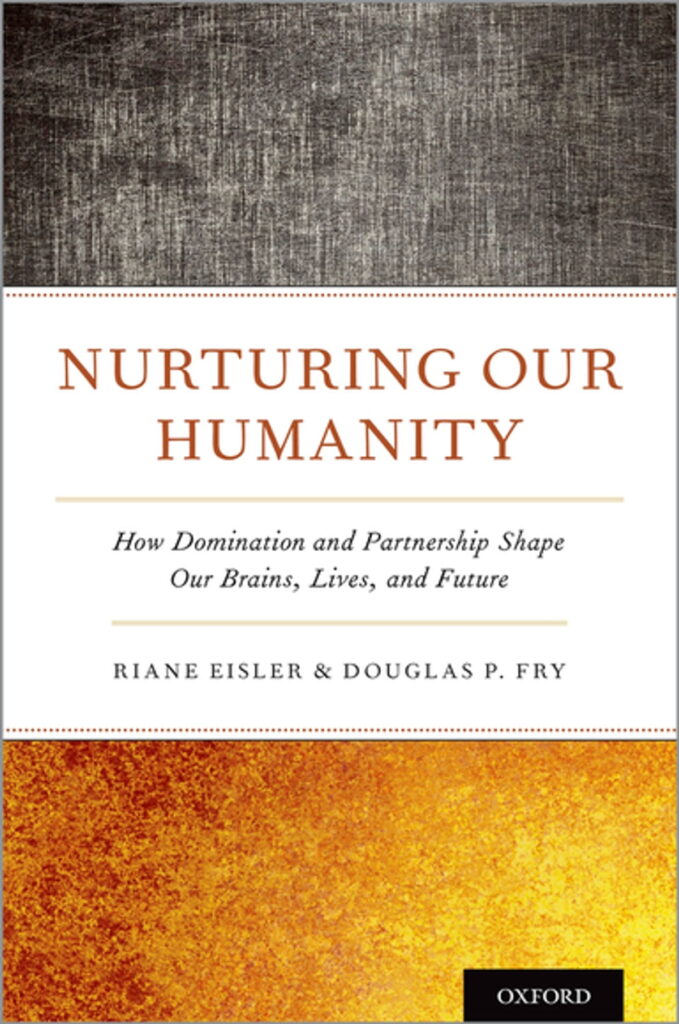
RE: Well, that is Nurturing Our Humanity, which came out with Oxford University Press in 2019, and draws heavily from the biological sciences, particularly neuroscience, and really supports my findings.
AA: I cannot wait to read that book. I’m so excited to know about it and we’ll order it as soon as we finish our episode today.
Dr. Eisler is also a keynote speaker and a revered teacher, and so I’m just so grateful for you to teach us today, Dr. Eisler. Thanks again for being here.
RE: It’s a pleasure to be with you.
AA: So I want to start our conversation and as you know, this season has been all about global patriarchy and how patriarchy developed in different regions of the world.
And today we’re focusing on Europe, but I wanted to start the episode with a foundational framework first which listeners will be familiar with, but I still want to just review at the beginning of episode; it’s the concept of dominator cultures or domination cultures and partnership cultures. And I want to frame the conversation around two episodes in European history wherein a dominator culture gained power and caused tremendous suffering.
So first we’ll talk about the invaders who disrupted egalitarian civilizations in the Neolithic period in Europe. And then second, we’ll talk about the rise of the Third Reich in the 1930s and 40s. So just to get us oriented to old Europe and the Neolithic cultures, can you tell us, Dr. Eisler, about some of the features of the partnership cultures in Neolithic Europe?
RE: Well, what we find is really a configuration. And this, I think, is the lasting value of this work: not only to show that a more partnership-oriented culture is possible, and of course, is much more effective and more humane in all of its institutions—from the family and education to politics and economics—but also to show that we can build, not to go back to any “good old days”, but that we know what we have to build in order to move forward.
And the characteristics of a partnership society are, first of all, that in contrast to a domination or dominator-oriented culture, there is not the authoritarianism, the top down rule, the violence really in both families and in the state or tribe. And this is very, very important because conventional analysis of societies really leave out the family, don’t they? Along with women and children, the majority of humanity were marginalized. So we have more democratic and economically equitable family and social structures.
Second, and again this is something that we would not know from the conventional discourse in which anything to do with gender equity or inequity or sexual harassment is coded a ‘women’s issue’. No, the issue of whether or not, as you will see, the genders (women, men, everyone in between) are equally valued is key to a partnership society. If only because along with the devaluation in domination systems of anything coded-connected with women or feminine come values such as caring and nonviolence, which in domination systems are then, really subordinated, whereas they are not. There are central values for women, men, and everyone in between. And of course, there’s much more mutual respect and trust, rather than this fear and mistrust. And you have beliefs and stories, and language that reflect empathy and caring relations.
AA: So when we talk about the partnership cultures specifically of old Europe, and you talk about this in The Chalice and the Blade, what are some specific examples of those civilizations that exhibited those traits that you just talked about? And specifically, it’s interesting because we can’t understand their written records; what is some evidence that they had these cultural values?
RE: Well, the evidence comes from so many disciplines. From archaeology, from the study of art—I mean art is a symbolic language—from the size of houses, from the so-called grave goods, from whether or not there are signs of destruction through warfare.
So, if you look at the cultures that existed for the vast, vast majority of our human cultural adventure on this earth, going way back to foraging times, which I deal with in conjunction with the co-author of Nurturing Our Humanity, the anthropologist Douglas Fry, who calls these millennia of more egalitarian, more gender-balanced, less-violent cultures that we lived in the ‘original partnership societies’.
And then if we look at the Neolithic, we see a very, very different picture. And remember that art is a symbolic language. And if you really pay attention, you’ll see that there is a notable absence in this ancient art of scenes of men killing others which becomes so ubiquitous, so common after the shift.
But let’s go back to the Old Stone Age to start with. Because what we find are these so-called Venus figurines all over Europe. And it’s really strange that these old school archaeologists called them Venus figurines, you know some form, I guess, of ancient pornography, but in fact these are faceless figures with very obvious etched vulvas, very protruding breasts perhaps pregnant…I mean, they’re really goddess figures, aren’t they? We know that until recent times, art has been mainly a reflection of what we call religious or spiritual beliefs. So starting there, you already see an art which doesn’t fit into the domination paradigm, does it?
But if you move now to the archaeological findings of the early Neolithic societies—for example, Çatalhöyük in Turkey, which is probably the largest Neolithic site ever excavated—you find dwellings of similar sizes, burials of similar wealth. You find almost no evidence of warfare. It’s really interesting. You find so many representations, again, not only of men but of women in their art and you find like the cover, for example, of The Chalice and the Blade is of a bird goddess from the Neolithic, and it’s really interesting because it shows that they had an ethos of interconnection, not only of female and male—you know, it has breasts, but it’s also phallic in shape—but of humans with nature. She’s a bird goddess.
art is a symbolic language. And if you really pay attention, you’ll see that there is a notable absence in this ancient art of scenes of men killing
So, and if we move really forward, you have much more in the art of Minoan Crete, which is probably the last European more partnership-oriented society, a tremendous celebration of nature, of the joy of living, the so-called dolphin fresco…it could be a modern ecology poster. It’s fascinating. And the so-called throne room is a small room with a very small throne, in which scholars, judging from other art, believe that a woman (perhaps the high priestess) was the one who sat on it. But these were not really palaces, the Palace of Knossos, they were more distribution centers and also spiritual centers.
AA: Yes, I’m actually looking at some replicas of frescoes from the Minoan people from the Minoan civilization. It’s right here on my desk. I have Minoan priestesses all through my house, and it is beautiful art, and there are the jugs with the octopus on them and, like you said, the dolphins everywhere. It’s just this beautiful, just this joyful art that does show, just like you said, this connection to nature.
And the other thing I wanted to mention too is how striking it is from the Minoans to see the bull jumpers and you see men and women in the public realm doing this ritual that involves this really scary gigantic bull and to see women in that arena. It’s very striking because you think, oh, you would never see this in much later European art. You would just never see a woman in that role, nor would you see a man as they’re depicted with butterflies around and flowers and stuff. So yes, I just adore Minoan art and learned about it largely through your book.
Let’s talk about the groups of people who invaded and disrupted these partnership societies. And I know you mentioned it a little bit, but let’s list some of the features of domination cultures.
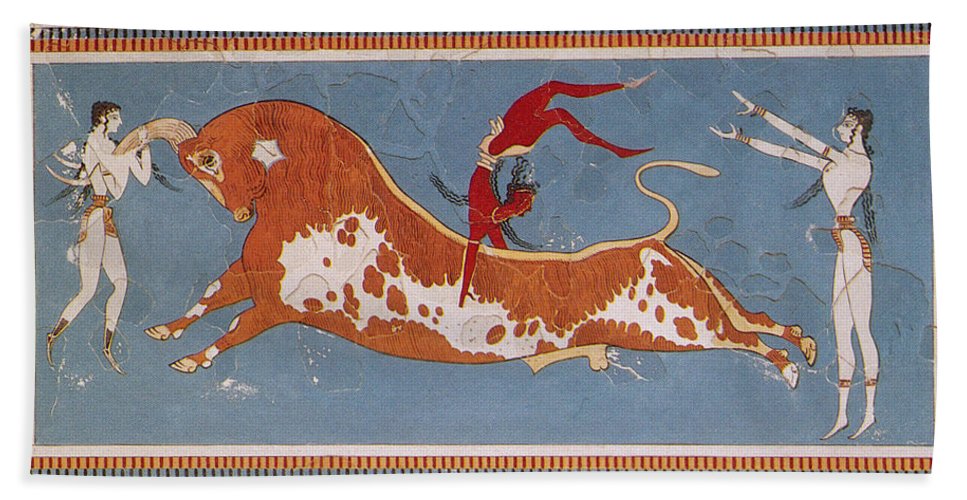
RE: Well, you have of course an authoritarian and inequitable and I should say punitive family and social structure. Lots of abuse, violence in both the family…and, of course, we know from neuroscience how important the first five years of our life are in terms of nothing less than how the architecture of our brains is formed, which is in interaction with our culture. In other words, you really have to take into account if you’re going to change, much less understand societies and our possibilities along the partnership-domination social scale, you have to understand that neuroscience is very clear that what children first observe and experience is critical. Yes, we can change all through our lives. We can even change the structures of our brains. But it is much more labor intensive than if we start already with a healthier way. And there are trends in this direction, like the shift from authoritarian to authoritative parenting styles.
A second characteristic of domination systems is, again, gender. You know, we are so used to being taught that well…even now that we finally have such a thing as women’s studies, right? They’re still marginalized in the academy, aren’t they? And to a very large extent we need to understand our history, including our prehistory. So in domination systems, whether it’s in Hitler’s Nazi Germany, the Taliban, Iran, you know, Eastern/Western, Stalin’s Former Soviet Union, Putin’s Russia today subordination of women and ‘femininity’ to men and ‘masculinity’ is key. And this is directly related to the fact that domination systems have a high degree of abuse and violence as is needed to maintain rankings of domination. And you have beliefs and stories that equate domination and violence with real masculinity. And starting really with the in group of mankind and the female other, you have a template for what distinguishes domination systems, which is in-groups versus out-groups.
I mean, in the United States, we see it in racism or in violence against other out-groups, like people of different sexual orientations, etc… But you also see it in the Middle East, for example, in Shia versus Sunni or Sunni versus Shia. And yes, domination is maintained and imposed by force and by fear.
AA: Yes, it’s just so tragic to hear it spelled out that way. And it was interesting to hear you mention more modern iterations of this and even ones that are happening today. And just again, that’s why these frameworks are just so useful because you can name what you see happening, whether it’s in ancient history or even now and say, Oh, yeah, I know what that is. I know the ethos and the value system that is being represented there.
RE: Well, the problem that we face is fragmentation of consciousness, and really, if you look at conventional studies or you look at conventional social categories like right/left, religious/secular, eastern/western, northern/southern, capitalist/socialist, without exception they subordinate really anything coded feminine, including women, of course.
AA: Well, backing up a bit, let’s go back quickly to the dominators that invaded old Europe and talk about how that happened. Who were the people who, and I know that there were many different settlements, many different societies throughout Europe, and this happened in different places in different times. But if you can kind of give us a bird’s eye view of, of who these dominators were that came and disrupted old Europe?
RE: Well, we know a lot about them through Indo European studies because these so-called Kurgans, or Indo-European invaders, that in three waves, really—4,300 before the Common Era, then another wave 3,400, before the Common Era, and then a third wave 3,000 years before the Common Era. We know that they were Indo Europeans or Aryans actually, as Hitler liked to glorify them. They were nomadic. In other words, they didn’t shift to farming from gathering and hunting. They shifted to herding and living off herds of live animals. But, you know, it’s very, very clear that they brought with them a domination social organization.
For one thing in terms of warfare, we know now from the archaeological record, that warfare is at most 5-10,000 years old. And that 5,000 really starts with the Kurgans in old Europe. And we have DNA studies showing that they pretty much replace the earlier populations. Very interesting. As the archaeologist Marija Gimbutas writes, they quite literally worshipped the lethal power of the blade. And of course we see it in the later gods of war and men of war that became predominant and dominant in our world. But it doesn’t have to be this way. And that’s really what people are beginning to understand: that whether it’s the conquest and domination of other people or the conquest and domination of nature, it’s all part of the domination system, isn’t it?
whether it’s the conquest and domination of other people or the conquest and domination of nature, it’s all part of the domination system
AA: One thing that you bring up in your books and then on your website as well as I was reviewing some of your information is that it’s always a spectrum, like there’s no culture that’s 100 percent dominator and no culture that’s 100 percent partnership every culture. And I’m sure in different aspects of the culture, you’ll have different aspects beyond different parts of the spectrum. But the goal. As I understand it, I guess, is just to move things over, wherever you are, toward partnership.
RE: Absolutely, and that is really the only way out of this mess that we’re in, economically, socially, environmentally.
AA: So how would you say that these ‘blade societies’ and domination set Europe on its trajectory? What are some of the features of the Western world that we inherited from those dominator societies from the Indo-Europeans who came and changed everything?
RE: Well, one thing we inherited are these rigid gender stereotypes and the ranking of so-called masculinity over so-called femininity, even by women who’ve been taught to internalize this.
Our economic systems, as I said, whether capitalist or socialist, are not just outdated. They also carry this system of gendered values in which anything coded feminine, like caregiving and nonviolence is devalued. And we inherited a worldview in which there are only two alternatives: you either dominate or you’re going to be dominated, in-group versus out-group. And of course, we’ve inherited this tradition of violence and abuse as ‘entertaining’, as blockbuster films, ancient epics with violent heroes (or more recently, heroines) idealized. And we have inherited families. And this is very, very basic, in which caring and coercion are really part and parcel of the same thing. You don’t get caring without coercion. That’s considered good parenting, as is necessary to socialize children into domination systems. And, we have inherited stories, language. All of the regressions to strongman rule in the state of where domination systems keep rebuilding themselves, whether it’s Putin’s Russia, the Taliban, North Korea, Iran, Trumpers, and of course the Nazis, they really have a domination configuration, whether they’re Eastern, Western, Northern, Southern, etc…
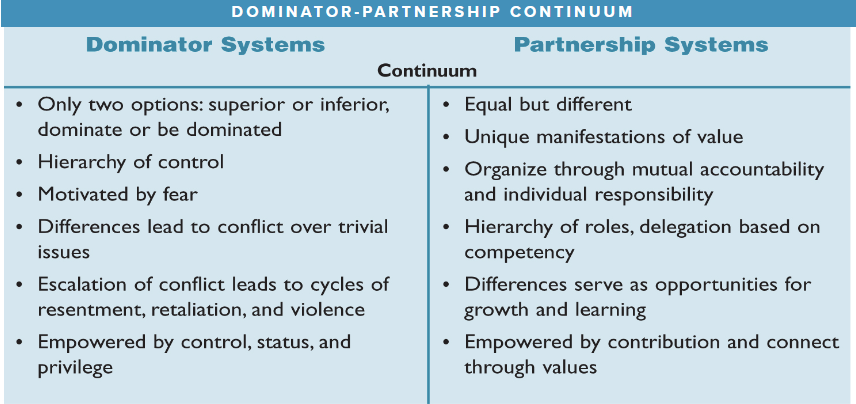
AA: I think it’s so interesting too, you talk about—even though as I just said, there isn’t a culture that’s 100 percent either one—but there are some cultures that are very heavily one and that that’s kind of the operating system that runs the whole thing. So that’s why you see maybe a dominator mentality and you see it on all the levels of society like in family structure, but you also see it in schools and you see it in incarceration and you see it in just…you look at any aspect of society and you’re like oh yep that’s running on a dominator operation system. I thought that was so interesting
RE: Well, you know it’s really interesting because we’ve been taught and certainly the more “higher education” we get the more we’re taught this.
But it permeates the whole culture. So you have always money for prisons. Well, what’s that? That’s the punitive male head of household that’s part of the domination structure, isn’t it? Where there’s always money for weapons and for wars. Well, what’s that? That’s the dominator archetype of a masculinity that’s inextricably intertwined with violence and domination.
And we’re coming out of it somewhat. I mean, challenging conventional stories about masculinity, but we have to understand that this is a fundamental organizing principle for society, for economics. And we see it very clearly in the tremendous focus on subordinating women and Hitler saying that the whole issue of emancipation of women is a ‘Jewish plot’, that women are held to a quota of just one in ten university students. It’s so obvious and yet so hidden from us.
So I hope that you can direct people to Kate Millett’s wonderful chapter. It’s a frightening chapter, on the extreme subordination of women in Nazi Germany. But if you really think about it, look at Trump, look at Bolsonaro, look at Putin. You know that in 2018, Bolsonaro radically reduced the penalty for family violence? So today, if you hurt or kill a woman, a child, or a man sometimes in a family, your penalty is much less than if you hurt or kill a stranger.
So he gets it. These people get it. They get the connection between a dominator family, a highly-punitive, rigidly-male dominated authoritarian family, and yes, a highly-punitive, violent, rigidly-male dominated authoritarian state. Putin gets it. So it’s time that we learn from those trying to push us back.
AA: Well, yes. And we’ll now move from the stories we just told about the Neolithic Europeans into the 20th century. And I did want to highlight the really deliberate subordination of women that happened during Hitler’s Third Reich, and this was something that I had never learned before and I encountered in a chapter of Kate Millett’s book, Sexual Politics, and it just floored me. We didn’t have time to highlight this part of her book on our own episode on Sexual Politics, and so I’m really glad that we have a chance to highlight it here. So if you’re okay with this, Dr. Eisler, maybe what I’ll do is read, excerpt from Millett’s book and we’ll talk about it thematically. And then you can talk about either something scholarly or something from your personal life in regards to the Third Reich.
So the first quote that I wanted to share from Millett is that she says that in her estimation, “the Third Reich was probably the most deliberate attempt ever made to revive and solidify extreme patriarchal conditions.” And when she says revive, she’s talking about the fact that women had made progress. They had won suffrage in 1919 with their enfranchisement protected under the Weimar Constitution. And for listeners, if you remember world history class, the Weimar period was between the wars. So there was World War I, which Germany lost and it was devastating for them, and then there’s the Weimar Republic that came before the 1930’s and then moving into World War II. So it’s that interwar period. So women had made a bunch of. Progress during that time, they had made strides and there was an organization called the Federation of Women that had formed in 1928. Can you tell us about this period for your family in Austria, Riane?
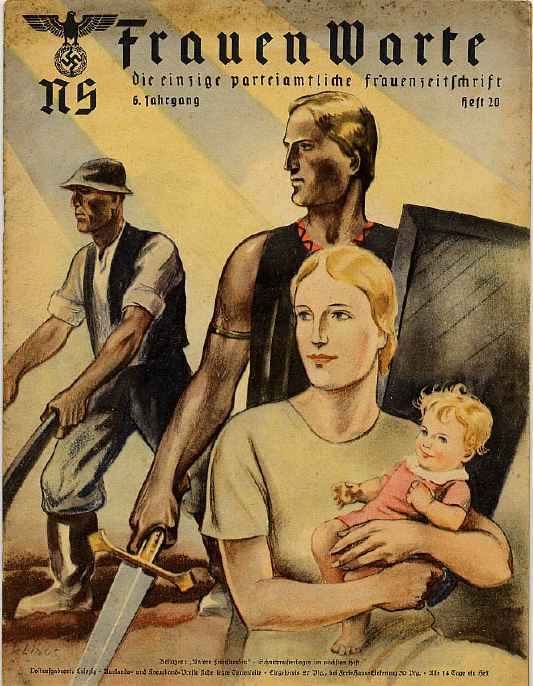
RE: Well, I think that the confluence really of the German message of the subordination of women with the in-group versus out-group thinking and then violence against Jews and other out-groups, is what affected me personally, of course, very much.
In fact, really, this work is so much rooted in the traumas of my childhood, in Crystal Night when a gang of Gestapo men came to our house and pushed my father down the stairs, dragged him off…you know, witnessing this violence and this inhumanity, that is basically the in-group versus out-group thinking makes inhumanity part of the system. It’s just possible to treat other humans that way.
But I also saw something else that night, which was of course, my mother standing up to this gang of Gestapo men, recognizing one of the men as a young man who had worked for the family business as a delivery person and just getting furious at him, telling him, how dare you do this to this man who has been so kind to you. I want him back. And some money passed hands eventually, and she did get him back.
AA: Tell us where he had been taken, because they took him out of your house, right?
RE: They took him into a waiting truck downstairs, you know, on the street where they were also arresting other men. They always started with some of the leaders, you know, in the community, in the Jewish community, and it was a very deliberate kind of…but it was the first official night of terror against Jews of the Nazi regime, in both Germany and in Nazi Austria at that time. And we would have stayed, like so many other women and children did. He would have been taken to Buchenwald, you know, a concentration camp, and we would eventually also have died and been taken off to a concentration camp because that was the method. It was a very deliberate method. But I want to say, when Millet says it was the most deliberate—you know, Taliban in Khomeini’s Iran, Stalin’s former Soviet Union, which she also mentions these, to varying degrees—all reinstate these rigid gender stereotypes and the ranking of anything coded masculine, violence, domination, over anything coded feminine, caring, caregiving, non-violence, which is a terrible disservice to men because this is not inherent in either women or men. It’s so much part of the socialization.
AA: Yes, I think that’s such a great point to bring up. And actually, as I was reading it out loud, I thought, Oh, that’s a bold claim to say this is the most deliberate when there have been so many that were so bad. The next quote that I was going to share from her would be…she says that Nazism set out to “storm the fortress” in a very methodical way.
RE: And that they did. That really distinguishes the Nazis because they had a very organized plan. For the Nazis, it was laid out, you know, and it was really laid out in Hitler’s Mein Kampf that they were going to persecute the Jews as the prototypical out-group. Eventually there would be the Holocaust and the systematic murder of six million Jews, as well as gypsies, communists, homosexuals, other out-groups that were killed.
AA: It’s really striking. One of the things that I remembered when I read the book before I had gone back to do this research for this episode, but the thing that jumped out to me the most was that they issued handbooks and pamphlets for leaders to say ‘here’s what we’re going to do in order to subordinate the women’. And, over the course of the podcast, I’ve emphasized more my personal belief, which is probably based on the privilege of my life that I’ve known so many gentle and wonderful and good men that like…usually men are not setting out to make women’s lives miserable on purpose. It’s just unconscious bias that we have, or we’ve all just been trained in this system. But this is an example of actual deliberate, purposeful subjugation, which really is striking. And if it’s okay, I’ll read a quote from Millett.
the ranking of anything coded masculine, violence, domination, over anything coded feminine, caring, caregiving, non-violence…is a terrible disservice to men
She says that the party, meaning the Nazi party, “had instructions for taking over the feminist organizations and they refer to a ‘bringing in line’ of the women’s organizations. One pamphlet reads: the executive bodies of the women’s associations are to be slowly penetrated. The religious groups are to be handled with caution. They cannot be brought into line in the same way as the other women’s clubs. Detailed instructions will appear shortly.” And then there’s another set of instructions for political leaders that says “the commissioner shall cause the women’s organizations themselves to accept a newly chosen leadership. Only when the organization refuses to accept the new staff member does the commissioner take over this office. Severity is to be avoided if possible.” And that’s the end of the quote. And so of course the commissioner taking over the office in the club would be a man, or it would be a woman that they choose who would uphold the system.
I would just was floored by that. I just couldn’t believe how cunning and strategic they were. And the fact that they said that severity should be avoided if possible. And I think that’s because that would have alerted the women to their motives. They were secretly trying to sneak and be really subversive in coming into these women’s clubs to replace the leadership. I just couldn’t believe it.
RE: Well, you know, I quoted some of—and I think it was partially from Kate Millet, partially from other sources—but Gottfried Feder who was one of the Nazis founding ‘thinkers’ said that “the Jew has stolen a woman from us through the forms of sex democracy. We, the youth, must march out to kill the dragon so that we may again attain the most holy thing in the world: the woman as maid and servant.” And there you have it. There you have it. I mean, gender equity is a Jewish plot. Hitler said it in a speech, “the message of woman’s emancipation is a message discovered solely by the Jewish intellect and its content is stamped with the same spirit.”

Well, that quote could have been really part of the Proud Boys or Oath Keepers, you know. But they’re anti-Semitic linking hatred of the Jewish ‘out-group’ along with the immigrant ‘out-group’ and the Black ‘out-group’ with women, with the subordination of women. You know, what Michael Kimmel called a ‘aggrieved entitlement’ is very much cultivated, isn’t it, as part of the old masculinity? Now, the good news is how many men are today saying, Wait a minute, I’m a human being and I don’t fit this gender stereotype. The bad news. is how it is being re-idealized and revived.
AA: One last thing that I wanted to highlight was the rollback of educational and career opportunities for women. So Kate Millett says, speaking at a meeting of the Nazi medical panel in December 1934, there was a man named Dr. Wagner who was the appointed leader of the medical profession in Germany and apparently he cried out before a mixed audience, “We will strangle higher education for women.” When the new regime had taken over, German women were forbidden to sit as judges. In 1936, they were forbidden to hold office in the courts and Millet points out that there were 30 women in the Reichstag, which is the Legislative Assembly when the Nazis came to power and by 1938, there were none, there were no women in the Legislative Assembly, and I guess this is the point is that they were doing that very purposefully.
Interestingly though, she then also says that women were not just at home. So despite all of this rhetoric and the pressure, the social pressure for women to leave the jobs to men, actually it was just the good jobs that they wanted to leave to the men. And Millett says, “Women were to make up the factory population which serviced and produced the German war machine, at least at the outset, and until their numbers were augmented with slave labor from Eastern Europe. For all the thundering propaganda about marriage, holy motherhood, and home, the number of employed women, even working mothers, increased under Nazi rule from 1933 onward. They were just confined to low paid labor that men didn’t want to do.”
RE: You know, I think we have to understand not as totalitarianism on the right, but as a version of the domination system. And I’m so glad that you’re doing this because you are showing, and certainly Millet showed, how systematic that really was.
AA: Dr. Eisler, I’m just so grateful for your time today, and it’s been so lovely to get to know you. I want to thank you for your work again and thank you for this conversation. It’s been such a pleasure.
RE: Well, it’s been a pleasure for me, and I congratulate you on what you’re doing, because we humans are extremely creative, and we can recreate not only our behaviors, but the social institutions and the system of values that undergird domination systems and reward domination behaviors and shift them to ones that really support a more equitable, more caring, more sustainable way of living and making a living.
we know what we have to build

in order to move forward
Listen to the Episode
&
Share your Comments with us below!


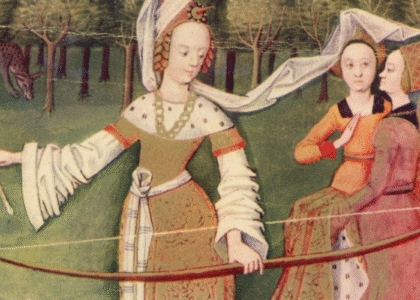



It was pretty exciting to learn that you interviewed THE Riane Eisler on your show! Since I read The Chalice and the Blade, I love how differently I’ve come to see the world. I’ve developed an undergrad course in sustainability with domination vs. partnership as a major theme, and it’s going very well. Amy, thanks so much for all your work!